Evaluating Risk and Governance in FIFA: Accountability Frameworks
VerifiedAdded on 2023/06/15
|19
|5232
|160
Report
AI Summary
This report provides an in-depth analysis of risk management and corporate governance within FIFA, focusing on the nature and relevance of risk to corporate accountability. It critically examines executive decision-making in relation to risk management and stewardship, referencing relevant risk management frameworks and theories such as agency theory and stakeholder theory. The report identifies and discusses specific risks faced by FIFA, including instances of bribery and governance failures, and suggests potential improvements in risk management strategies. Furthermore, it compares and contrasts FIFA's approach to corporate governance with that of other entities like Statoil, drawing on established corporate governance theories to highlight areas for improvement and ensure greater accountability and transparency within the organization. Desklib offers this assignment solution and many other resources for students.

Paraphrase This Document
Need a fresh take? Get an instant paraphrase of this document with our AI Paraphraser
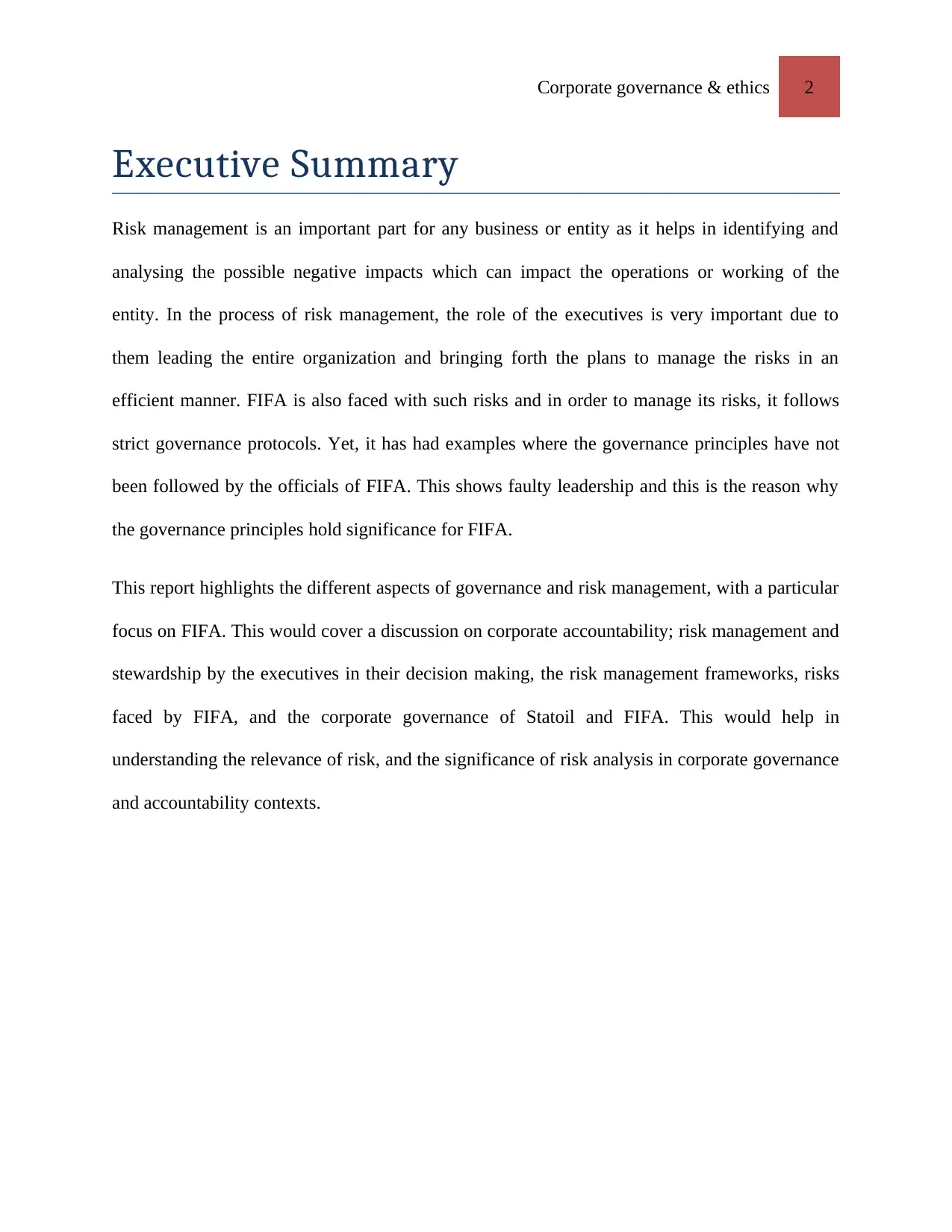
Corporate governance & ethics 2
Executive Summary
Risk management is an important part for any business or entity as it helps in identifying and
analysing the possible negative impacts which can impact the operations or working of the
entity. In the process of risk management, the role of the executives is very important due to
them leading the entire organization and bringing forth the plans to manage the risks in an
efficient manner. FIFA is also faced with such risks and in order to manage its risks, it follows
strict governance protocols. Yet, it has had examples where the governance principles have not
been followed by the officials of FIFA. This shows faulty leadership and this is the reason why
the governance principles hold significance for FIFA.
This report highlights the different aspects of governance and risk management, with a particular
focus on FIFA. This would cover a discussion on corporate accountability; risk management and
stewardship by the executives in their decision making, the risk management frameworks, risks
faced by FIFA, and the corporate governance of Statoil and FIFA. This would help in
understanding the relevance of risk, and the significance of risk analysis in corporate governance
and accountability contexts.
Executive Summary
Risk management is an important part for any business or entity as it helps in identifying and
analysing the possible negative impacts which can impact the operations or working of the
entity. In the process of risk management, the role of the executives is very important due to
them leading the entire organization and bringing forth the plans to manage the risks in an
efficient manner. FIFA is also faced with such risks and in order to manage its risks, it follows
strict governance protocols. Yet, it has had examples where the governance principles have not
been followed by the officials of FIFA. This shows faulty leadership and this is the reason why
the governance principles hold significance for FIFA.
This report highlights the different aspects of governance and risk management, with a particular
focus on FIFA. This would cover a discussion on corporate accountability; risk management and
stewardship by the executives in their decision making, the risk management frameworks, risks
faced by FIFA, and the corporate governance of Statoil and FIFA. This would help in
understanding the relevance of risk, and the significance of risk analysis in corporate governance
and accountability contexts.
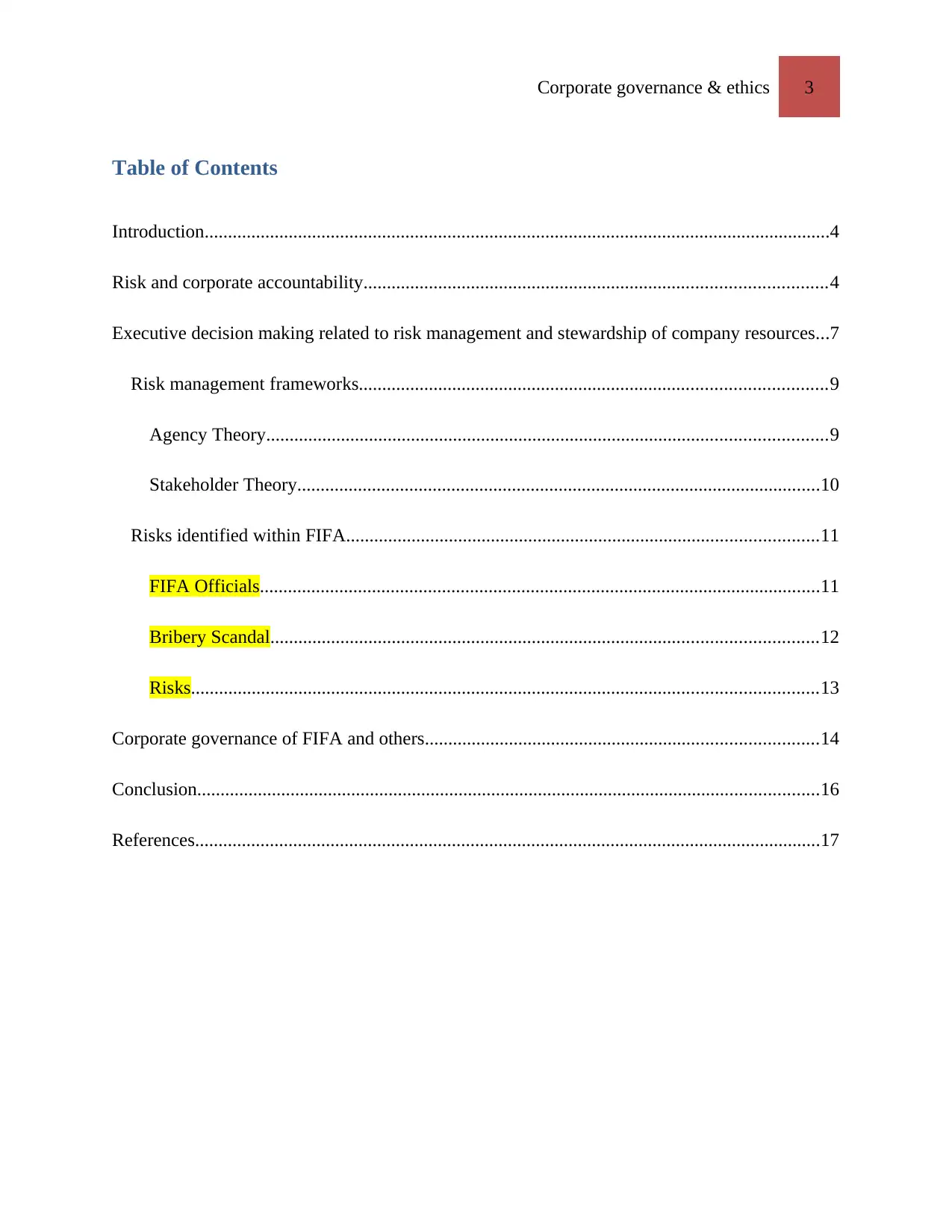
Corporate governance & ethics 3
Table of Contents
Introduction......................................................................................................................................4
Risk and corporate accountability...................................................................................................4
Executive decision making related to risk management and stewardship of company resources...7
Risk management frameworks....................................................................................................9
Agency Theory........................................................................................................................9
Stakeholder Theory................................................................................................................10
Risks identified within FIFA.....................................................................................................11
FIFA Officials........................................................................................................................11
Bribery Scandal.....................................................................................................................12
Risks......................................................................................................................................13
Corporate governance of FIFA and others....................................................................................14
Conclusion.....................................................................................................................................16
References......................................................................................................................................17
Table of Contents
Introduction......................................................................................................................................4
Risk and corporate accountability...................................................................................................4
Executive decision making related to risk management and stewardship of company resources...7
Risk management frameworks....................................................................................................9
Agency Theory........................................................................................................................9
Stakeholder Theory................................................................................................................10
Risks identified within FIFA.....................................................................................................11
FIFA Officials........................................................................................................................11
Bribery Scandal.....................................................................................................................12
Risks......................................................................................................................................13
Corporate governance of FIFA and others....................................................................................14
Conclusion.....................................................................................................................................16
References......................................................................................................................................17
⊘ This is a preview!⊘
Do you want full access?
Subscribe today to unlock all pages.

Trusted by 1+ million students worldwide
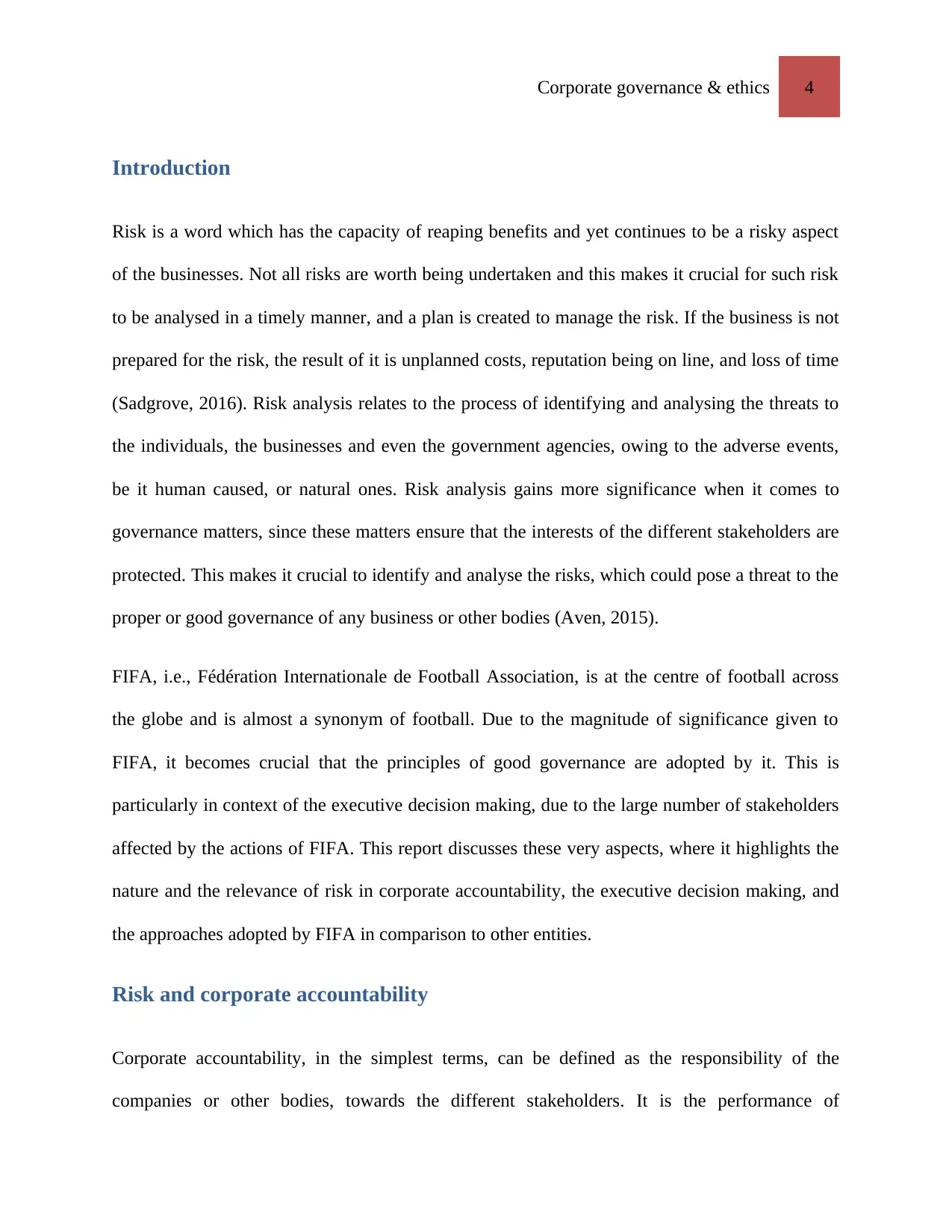
Corporate governance & ethics 4
Introduction
Risk is a word which has the capacity of reaping benefits and yet continues to be a risky aspect
of the businesses. Not all risks are worth being undertaken and this makes it crucial for such risk
to be analysed in a timely manner, and a plan is created to manage the risk. If the business is not
prepared for the risk, the result of it is unplanned costs, reputation being on line, and loss of time
(Sadgrove, 2016). Risk analysis relates to the process of identifying and analysing the threats to
the individuals, the businesses and even the government agencies, owing to the adverse events,
be it human caused, or natural ones. Risk analysis gains more significance when it comes to
governance matters, since these matters ensure that the interests of the different stakeholders are
protected. This makes it crucial to identify and analyse the risks, which could pose a threat to the
proper or good governance of any business or other bodies (Aven, 2015).
FIFA, i.e., Fédération Internationale de Football Association, is at the centre of football across
the globe and is almost a synonym of football. Due to the magnitude of significance given to
FIFA, it becomes crucial that the principles of good governance are adopted by it. This is
particularly in context of the executive decision making, due to the large number of stakeholders
affected by the actions of FIFA. This report discusses these very aspects, where it highlights the
nature and the relevance of risk in corporate accountability, the executive decision making, and
the approaches adopted by FIFA in comparison to other entities.
Risk and corporate accountability
Corporate accountability, in the simplest terms, can be defined as the responsibility of the
companies or other bodies, towards the different stakeholders. It is the performance of
Introduction
Risk is a word which has the capacity of reaping benefits and yet continues to be a risky aspect
of the businesses. Not all risks are worth being undertaken and this makes it crucial for such risk
to be analysed in a timely manner, and a plan is created to manage the risk. If the business is not
prepared for the risk, the result of it is unplanned costs, reputation being on line, and loss of time
(Sadgrove, 2016). Risk analysis relates to the process of identifying and analysing the threats to
the individuals, the businesses and even the government agencies, owing to the adverse events,
be it human caused, or natural ones. Risk analysis gains more significance when it comes to
governance matters, since these matters ensure that the interests of the different stakeholders are
protected. This makes it crucial to identify and analyse the risks, which could pose a threat to the
proper or good governance of any business or other bodies (Aven, 2015).
FIFA, i.e., Fédération Internationale de Football Association, is at the centre of football across
the globe and is almost a synonym of football. Due to the magnitude of significance given to
FIFA, it becomes crucial that the principles of good governance are adopted by it. This is
particularly in context of the executive decision making, due to the large number of stakeholders
affected by the actions of FIFA. This report discusses these very aspects, where it highlights the
nature and the relevance of risk in corporate accountability, the executive decision making, and
the approaches adopted by FIFA in comparison to other entities.
Risk and corporate accountability
Corporate accountability, in the simplest terms, can be defined as the responsibility of the
companies or other bodies, towards the different stakeholders. It is the performance of
Paraphrase This Document
Need a fresh take? Get an instant paraphrase of this document with our AI Paraphraser
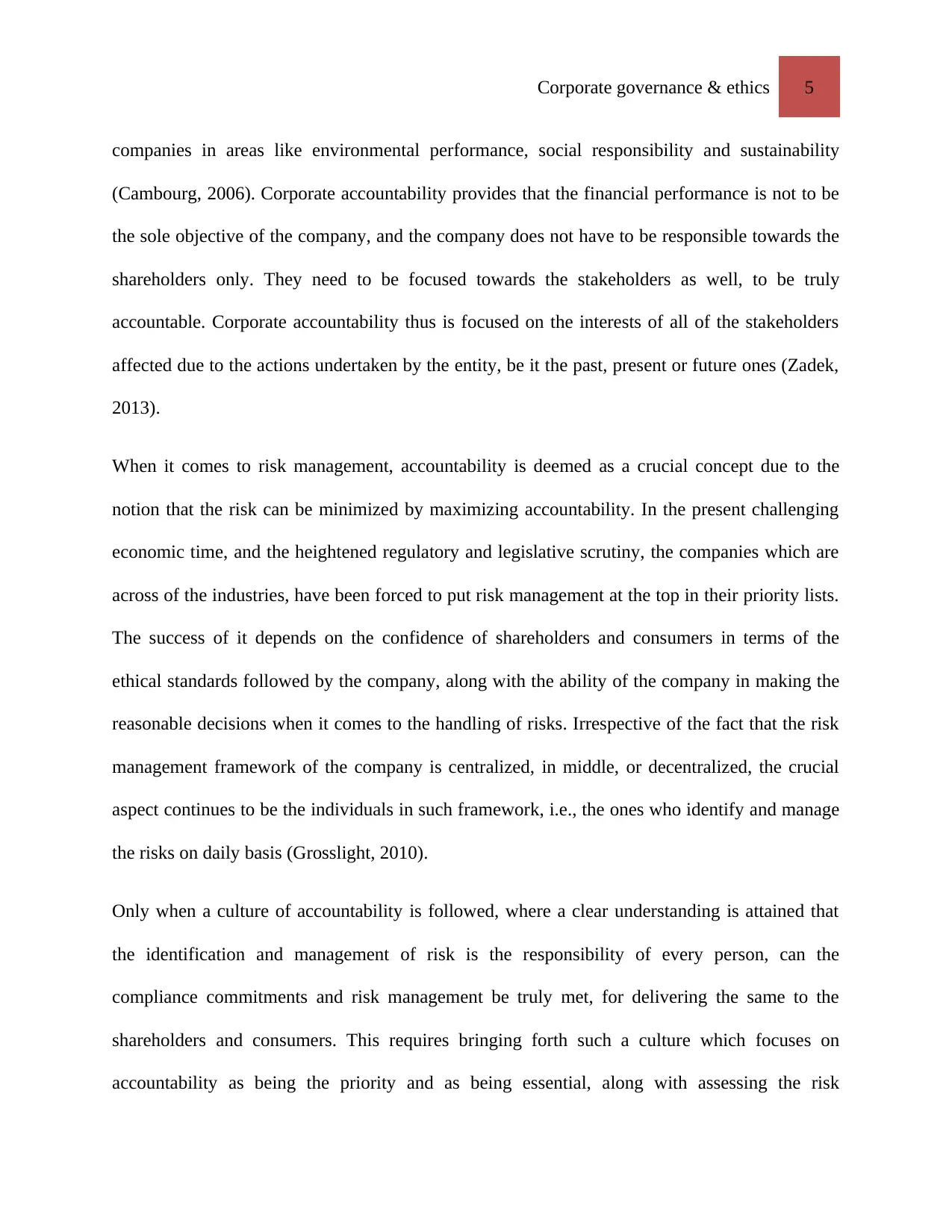
Corporate governance & ethics 5
companies in areas like environmental performance, social responsibility and sustainability
(Cambourg, 2006). Corporate accountability provides that the financial performance is not to be
the sole objective of the company, and the company does not have to be responsible towards the
shareholders only. They need to be focused towards the stakeholders as well, to be truly
accountable. Corporate accountability thus is focused on the interests of all of the stakeholders
affected due to the actions undertaken by the entity, be it the past, present or future ones (Zadek,
2013).
When it comes to risk management, accountability is deemed as a crucial concept due to the
notion that the risk can be minimized by maximizing accountability. In the present challenging
economic time, and the heightened regulatory and legislative scrutiny, the companies which are
across of the industries, have been forced to put risk management at the top in their priority lists.
The success of it depends on the confidence of shareholders and consumers in terms of the
ethical standards followed by the company, along with the ability of the company in making the
reasonable decisions when it comes to the handling of risks. Irrespective of the fact that the risk
management framework of the company is centralized, in middle, or decentralized, the crucial
aspect continues to be the individuals in such framework, i.e., the ones who identify and manage
the risks on daily basis (Grosslight, 2010).
Only when a culture of accountability is followed, where a clear understanding is attained that
the identification and management of risk is the responsibility of every person, can the
compliance commitments and risk management be truly met, for delivering the same to the
shareholders and consumers. This requires bringing forth such a culture which focuses on
accountability as being the priority and as being essential, along with assessing the risk
companies in areas like environmental performance, social responsibility and sustainability
(Cambourg, 2006). Corporate accountability provides that the financial performance is not to be
the sole objective of the company, and the company does not have to be responsible towards the
shareholders only. They need to be focused towards the stakeholders as well, to be truly
accountable. Corporate accountability thus is focused on the interests of all of the stakeholders
affected due to the actions undertaken by the entity, be it the past, present or future ones (Zadek,
2013).
When it comes to risk management, accountability is deemed as a crucial concept due to the
notion that the risk can be minimized by maximizing accountability. In the present challenging
economic time, and the heightened regulatory and legislative scrutiny, the companies which are
across of the industries, have been forced to put risk management at the top in their priority lists.
The success of it depends on the confidence of shareholders and consumers in terms of the
ethical standards followed by the company, along with the ability of the company in making the
reasonable decisions when it comes to the handling of risks. Irrespective of the fact that the risk
management framework of the company is centralized, in middle, or decentralized, the crucial
aspect continues to be the individuals in such framework, i.e., the ones who identify and manage
the risks on daily basis (Grosslight, 2010).
Only when a culture of accountability is followed, where a clear understanding is attained that
the identification and management of risk is the responsibility of every person, can the
compliance commitments and risk management be truly met, for delivering the same to the
shareholders and consumers. This requires bringing forth such a culture which focuses on
accountability as being the priority and as being essential, along with assessing the risk
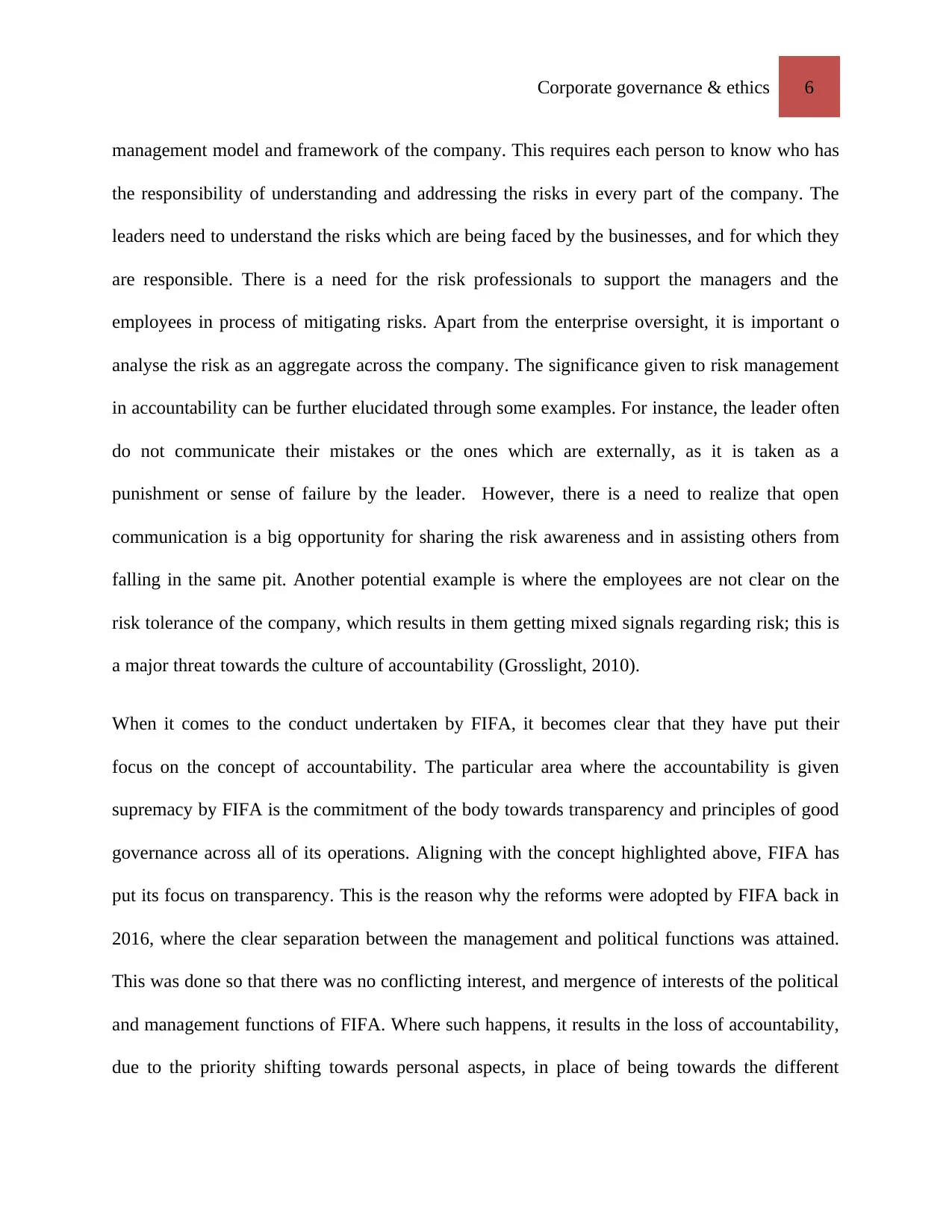
Corporate governance & ethics 6
management model and framework of the company. This requires each person to know who has
the responsibility of understanding and addressing the risks in every part of the company. The
leaders need to understand the risks which are being faced by the businesses, and for which they
are responsible. There is a need for the risk professionals to support the managers and the
employees in process of mitigating risks. Apart from the enterprise oversight, it is important o
analyse the risk as an aggregate across the company. The significance given to risk management
in accountability can be further elucidated through some examples. For instance, the leader often
do not communicate their mistakes or the ones which are externally, as it is taken as a
punishment or sense of failure by the leader. However, there is a need to realize that open
communication is a big opportunity for sharing the risk awareness and in assisting others from
falling in the same pit. Another potential example is where the employees are not clear on the
risk tolerance of the company, which results in them getting mixed signals regarding risk; this is
a major threat towards the culture of accountability (Grosslight, 2010).
When it comes to the conduct undertaken by FIFA, it becomes clear that they have put their
focus on the concept of accountability. The particular area where the accountability is given
supremacy by FIFA is the commitment of the body towards transparency and principles of good
governance across all of its operations. Aligning with the concept highlighted above, FIFA has
put its focus on transparency. This is the reason why the reforms were adopted by FIFA back in
2016, where the clear separation between the management and political functions was attained.
This was done so that there was no conflicting interest, and mergence of interests of the political
and management functions of FIFA. Where such happens, it results in the loss of accountability,
due to the priority shifting towards personal aspects, in place of being towards the different
management model and framework of the company. This requires each person to know who has
the responsibility of understanding and addressing the risks in every part of the company. The
leaders need to understand the risks which are being faced by the businesses, and for which they
are responsible. There is a need for the risk professionals to support the managers and the
employees in process of mitigating risks. Apart from the enterprise oversight, it is important o
analyse the risk as an aggregate across the company. The significance given to risk management
in accountability can be further elucidated through some examples. For instance, the leader often
do not communicate their mistakes or the ones which are externally, as it is taken as a
punishment or sense of failure by the leader. However, there is a need to realize that open
communication is a big opportunity for sharing the risk awareness and in assisting others from
falling in the same pit. Another potential example is where the employees are not clear on the
risk tolerance of the company, which results in them getting mixed signals regarding risk; this is
a major threat towards the culture of accountability (Grosslight, 2010).
When it comes to the conduct undertaken by FIFA, it becomes clear that they have put their
focus on the concept of accountability. The particular area where the accountability is given
supremacy by FIFA is the commitment of the body towards transparency and principles of good
governance across all of its operations. Aligning with the concept highlighted above, FIFA has
put its focus on transparency. This is the reason why the reforms were adopted by FIFA back in
2016, where the clear separation between the management and political functions was attained.
This was done so that there was no conflicting interest, and mergence of interests of the political
and management functions of FIFA. Where such happens, it results in the loss of accountability,
due to the priority shifting towards personal aspects, in place of being towards the different
⊘ This is a preview!⊘
Do you want full access?
Subscribe today to unlock all pages.

Trusted by 1+ million students worldwide
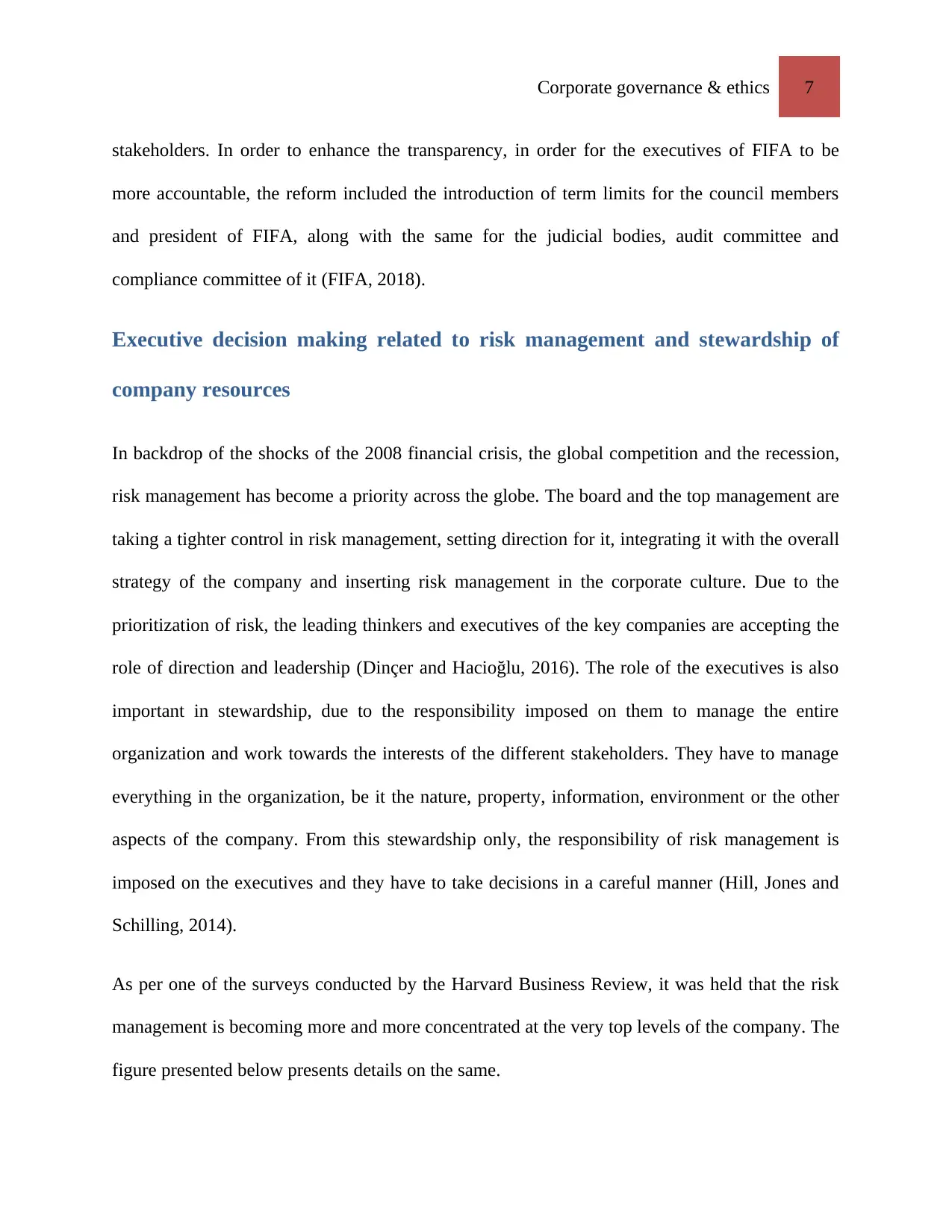
Corporate governance & ethics 7
stakeholders. In order to enhance the transparency, in order for the executives of FIFA to be
more accountable, the reform included the introduction of term limits for the council members
and president of FIFA, along with the same for the judicial bodies, audit committee and
compliance committee of it (FIFA, 2018).
Executive decision making related to risk management and stewardship of
company resources
In backdrop of the shocks of the 2008 financial crisis, the global competition and the recession,
risk management has become a priority across the globe. The board and the top management are
taking a tighter control in risk management, setting direction for it, integrating it with the overall
strategy of the company and inserting risk management in the corporate culture. Due to the
prioritization of risk, the leading thinkers and executives of the key companies are accepting the
role of direction and leadership (Dinçer and Hacioğlu, 2016). The role of the executives is also
important in stewardship, due to the responsibility imposed on them to manage the entire
organization and work towards the interests of the different stakeholders. They have to manage
everything in the organization, be it the nature, property, information, environment or the other
aspects of the company. From this stewardship only, the responsibility of risk management is
imposed on the executives and they have to take decisions in a careful manner (Hill, Jones and
Schilling, 2014).
As per one of the surveys conducted by the Harvard Business Review, it was held that the risk
management is becoming more and more concentrated at the very top levels of the company. The
figure presented below presents details on the same.
stakeholders. In order to enhance the transparency, in order for the executives of FIFA to be
more accountable, the reform included the introduction of term limits for the council members
and president of FIFA, along with the same for the judicial bodies, audit committee and
compliance committee of it (FIFA, 2018).
Executive decision making related to risk management and stewardship of
company resources
In backdrop of the shocks of the 2008 financial crisis, the global competition and the recession,
risk management has become a priority across the globe. The board and the top management are
taking a tighter control in risk management, setting direction for it, integrating it with the overall
strategy of the company and inserting risk management in the corporate culture. Due to the
prioritization of risk, the leading thinkers and executives of the key companies are accepting the
role of direction and leadership (Dinçer and Hacioğlu, 2016). The role of the executives is also
important in stewardship, due to the responsibility imposed on them to manage the entire
organization and work towards the interests of the different stakeholders. They have to manage
everything in the organization, be it the nature, property, information, environment or the other
aspects of the company. From this stewardship only, the responsibility of risk management is
imposed on the executives and they have to take decisions in a careful manner (Hill, Jones and
Schilling, 2014).
As per one of the surveys conducted by the Harvard Business Review, it was held that the risk
management is becoming more and more concentrated at the very top levels of the company. The
figure presented below presents details on the same.
Paraphrase This Document
Need a fresh take? Get an instant paraphrase of this document with our AI Paraphraser
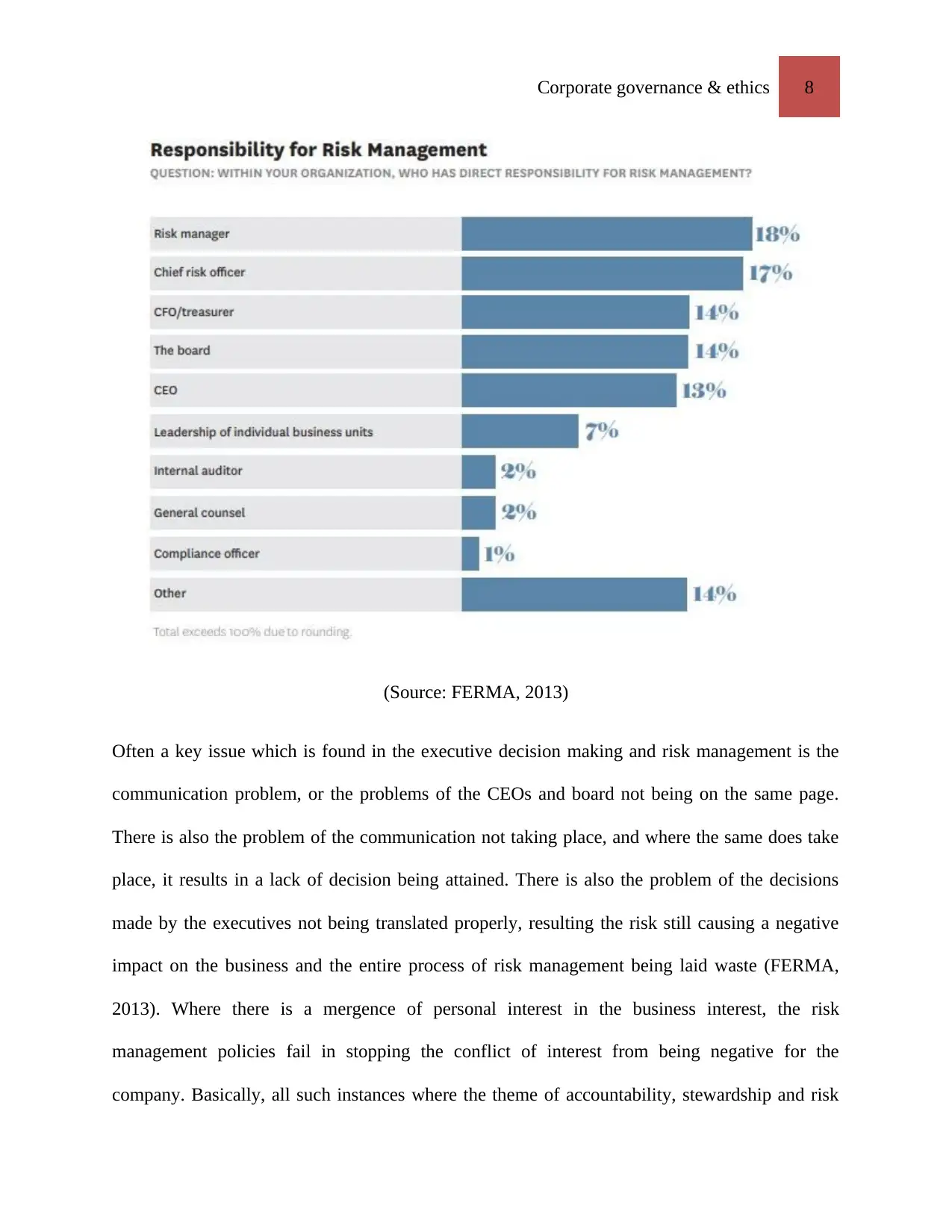
Corporate governance & ethics 8
(Source: FERMA, 2013)
Often a key issue which is found in the executive decision making and risk management is the
communication problem, or the problems of the CEOs and board not being on the same page.
There is also the problem of the communication not taking place, and where the same does take
place, it results in a lack of decision being attained. There is also the problem of the decisions
made by the executives not being translated properly, resulting the risk still causing a negative
impact on the business and the entire process of risk management being laid waste (FERMA,
2013). Where there is a mergence of personal interest in the business interest, the risk
management policies fail in stopping the conflict of interest from being negative for the
company. Basically, all such instances where the theme of accountability, stewardship and risk
(Source: FERMA, 2013)
Often a key issue which is found in the executive decision making and risk management is the
communication problem, or the problems of the CEOs and board not being on the same page.
There is also the problem of the communication not taking place, and where the same does take
place, it results in a lack of decision being attained. There is also the problem of the decisions
made by the executives not being translated properly, resulting the risk still causing a negative
impact on the business and the entire process of risk management being laid waste (FERMA,
2013). Where there is a mergence of personal interest in the business interest, the risk
management policies fail in stopping the conflict of interest from being negative for the
company. Basically, all such instances where the theme of accountability, stewardship and risk
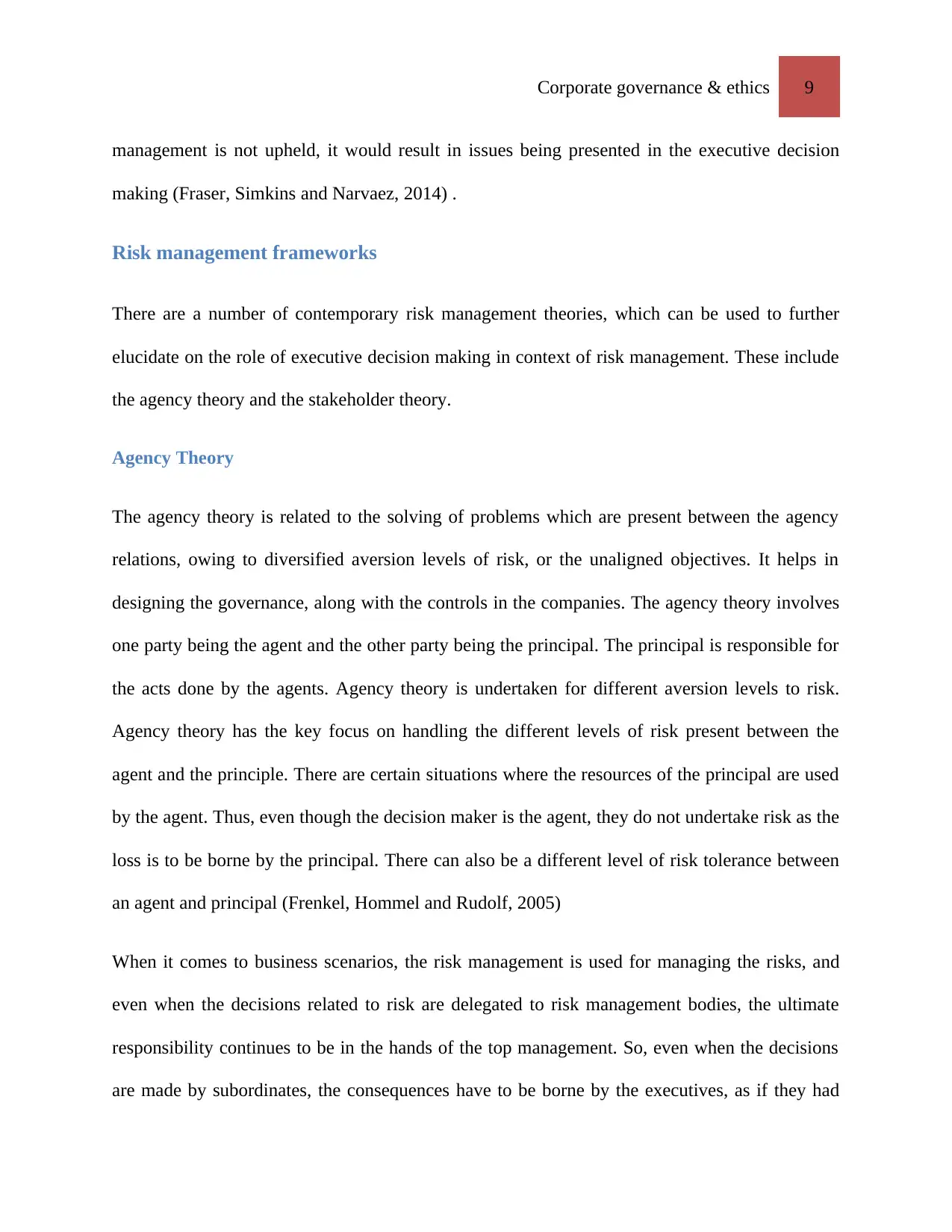
Corporate governance & ethics 9
management is not upheld, it would result in issues being presented in the executive decision
making (Fraser, Simkins and Narvaez, 2014) .
Risk management frameworks
There are a number of contemporary risk management theories, which can be used to further
elucidate on the role of executive decision making in context of risk management. These include
the agency theory and the stakeholder theory.
Agency Theory
The agency theory is related to the solving of problems which are present between the agency
relations, owing to diversified aversion levels of risk, or the unaligned objectives. It helps in
designing the governance, along with the controls in the companies. The agency theory involves
one party being the agent and the other party being the principal. The principal is responsible for
the acts done by the agents. Agency theory is undertaken for different aversion levels to risk.
Agency theory has the key focus on handling the different levels of risk present between the
agent and the principle. There are certain situations where the resources of the principal are used
by the agent. Thus, even though the decision maker is the agent, they do not undertake risk as the
loss is to be borne by the principal. There can also be a different level of risk tolerance between
an agent and principal (Frenkel, Hommel and Rudolf, 2005)
When it comes to business scenarios, the risk management is used for managing the risks, and
even when the decisions related to risk are delegated to risk management bodies, the ultimate
responsibility continues to be in the hands of the top management. So, even when the decisions
are made by subordinates, the consequences have to be borne by the executives, as if they had
management is not upheld, it would result in issues being presented in the executive decision
making (Fraser, Simkins and Narvaez, 2014) .
Risk management frameworks
There are a number of contemporary risk management theories, which can be used to further
elucidate on the role of executive decision making in context of risk management. These include
the agency theory and the stakeholder theory.
Agency Theory
The agency theory is related to the solving of problems which are present between the agency
relations, owing to diversified aversion levels of risk, or the unaligned objectives. It helps in
designing the governance, along with the controls in the companies. The agency theory involves
one party being the agent and the other party being the principal. The principal is responsible for
the acts done by the agents. Agency theory is undertaken for different aversion levels to risk.
Agency theory has the key focus on handling the different levels of risk present between the
agent and the principle. There are certain situations where the resources of the principal are used
by the agent. Thus, even though the decision maker is the agent, they do not undertake risk as the
loss is to be borne by the principal. There can also be a different level of risk tolerance between
an agent and principal (Frenkel, Hommel and Rudolf, 2005)
When it comes to business scenarios, the risk management is used for managing the risks, and
even when the decisions related to risk are delegated to risk management bodies, the ultimate
responsibility continues to be in the hands of the top management. So, even when the decisions
are made by subordinates, the consequences have to be borne by the executives, as if they had
⊘ This is a preview!⊘
Do you want full access?
Subscribe today to unlock all pages.

Trusted by 1+ million students worldwide
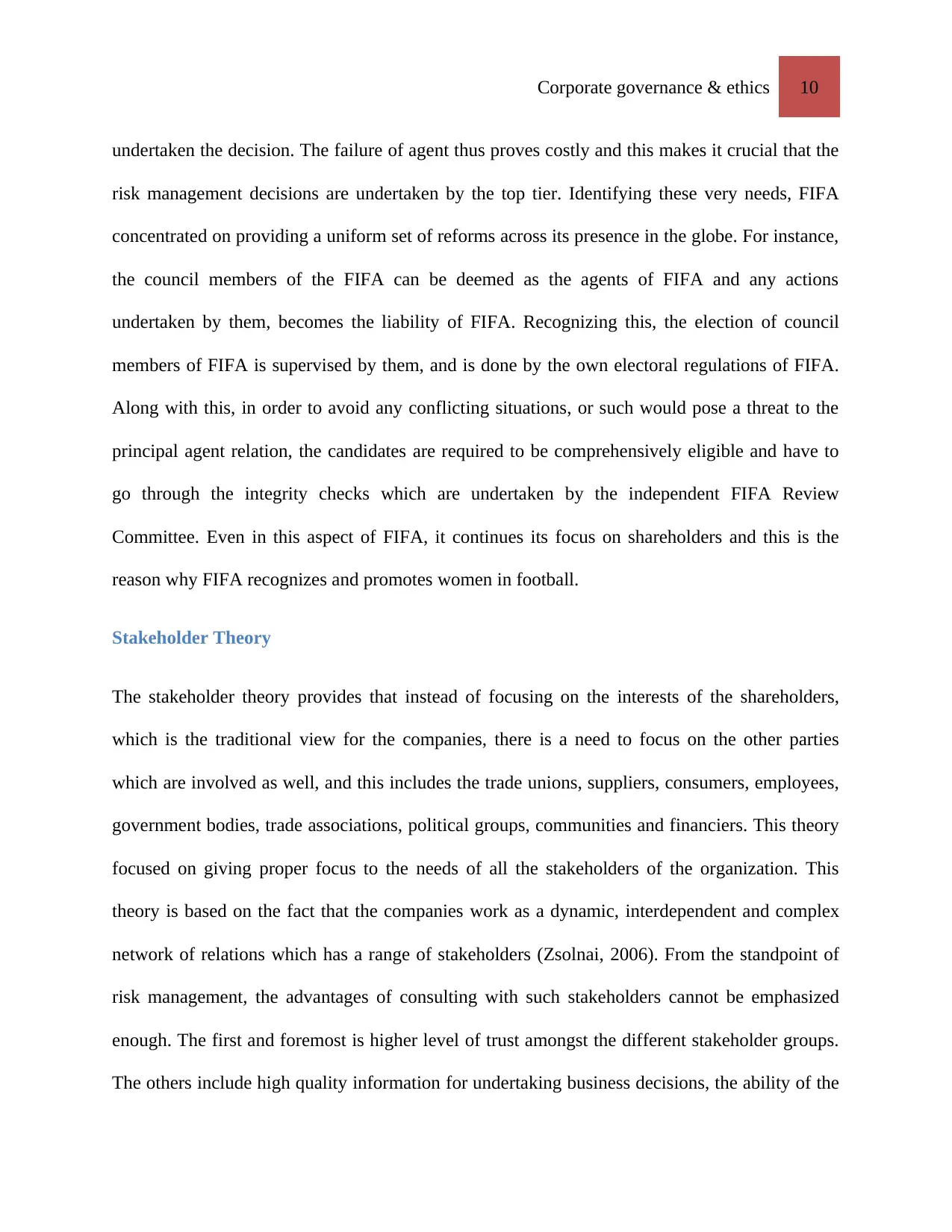
Corporate governance & ethics 10
undertaken the decision. The failure of agent thus proves costly and this makes it crucial that the
risk management decisions are undertaken by the top tier. Identifying these very needs, FIFA
concentrated on providing a uniform set of reforms across its presence in the globe. For instance,
the council members of the FIFA can be deemed as the agents of FIFA and any actions
undertaken by them, becomes the liability of FIFA. Recognizing this, the election of council
members of FIFA is supervised by them, and is done by the own electoral regulations of FIFA.
Along with this, in order to avoid any conflicting situations, or such would pose a threat to the
principal agent relation, the candidates are required to be comprehensively eligible and have to
go through the integrity checks which are undertaken by the independent FIFA Review
Committee. Even in this aspect of FIFA, it continues its focus on shareholders and this is the
reason why FIFA recognizes and promotes women in football.
Stakeholder Theory
The stakeholder theory provides that instead of focusing on the interests of the shareholders,
which is the traditional view for the companies, there is a need to focus on the other parties
which are involved as well, and this includes the trade unions, suppliers, consumers, employees,
government bodies, trade associations, political groups, communities and financiers. This theory
focused on giving proper focus to the needs of all the stakeholders of the organization. This
theory is based on the fact that the companies work as a dynamic, interdependent and complex
network of relations which has a range of stakeholders (Zsolnai, 2006). From the standpoint of
risk management, the advantages of consulting with such stakeholders cannot be emphasized
enough. The first and foremost is higher level of trust amongst the different stakeholder groups.
The others include high quality information for undertaking business decisions, the ability of the
undertaken the decision. The failure of agent thus proves costly and this makes it crucial that the
risk management decisions are undertaken by the top tier. Identifying these very needs, FIFA
concentrated on providing a uniform set of reforms across its presence in the globe. For instance,
the council members of the FIFA can be deemed as the agents of FIFA and any actions
undertaken by them, becomes the liability of FIFA. Recognizing this, the election of council
members of FIFA is supervised by them, and is done by the own electoral regulations of FIFA.
Along with this, in order to avoid any conflicting situations, or such would pose a threat to the
principal agent relation, the candidates are required to be comprehensively eligible and have to
go through the integrity checks which are undertaken by the independent FIFA Review
Committee. Even in this aspect of FIFA, it continues its focus on shareholders and this is the
reason why FIFA recognizes and promotes women in football.
Stakeholder Theory
The stakeholder theory provides that instead of focusing on the interests of the shareholders,
which is the traditional view for the companies, there is a need to focus on the other parties
which are involved as well, and this includes the trade unions, suppliers, consumers, employees,
government bodies, trade associations, political groups, communities and financiers. This theory
focused on giving proper focus to the needs of all the stakeholders of the organization. This
theory is based on the fact that the companies work as a dynamic, interdependent and complex
network of relations which has a range of stakeholders (Zsolnai, 2006). From the standpoint of
risk management, the advantages of consulting with such stakeholders cannot be emphasized
enough. The first and foremost is higher level of trust amongst the different stakeholder groups.
The others include high quality information for undertaking business decisions, the ability of the
Paraphrase This Document
Need a fresh take? Get an instant paraphrase of this document with our AI Paraphraser
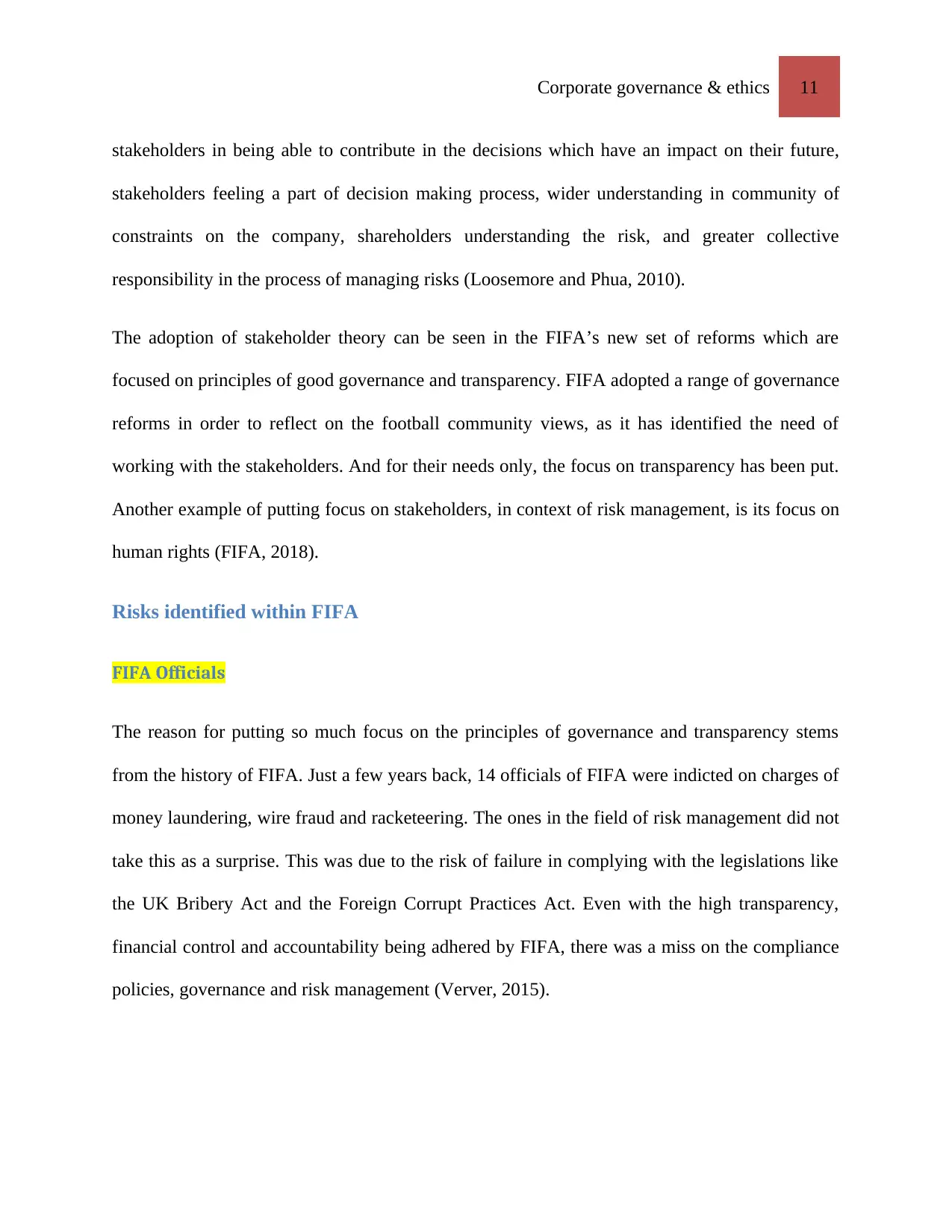
Corporate governance & ethics 11
stakeholders in being able to contribute in the decisions which have an impact on their future,
stakeholders feeling a part of decision making process, wider understanding in community of
constraints on the company, shareholders understanding the risk, and greater collective
responsibility in the process of managing risks (Loosemore and Phua, 2010).
The adoption of stakeholder theory can be seen in the FIFA’s new set of reforms which are
focused on principles of good governance and transparency. FIFA adopted a range of governance
reforms in order to reflect on the football community views, as it has identified the need of
working with the stakeholders. And for their needs only, the focus on transparency has been put.
Another example of putting focus on stakeholders, in context of risk management, is its focus on
human rights (FIFA, 2018).
Risks identified within FIFA
FIFA Officials
The reason for putting so much focus on the principles of governance and transparency stems
from the history of FIFA. Just a few years back, 14 officials of FIFA were indicted on charges of
money laundering, wire fraud and racketeering. The ones in the field of risk management did not
take this as a surprise. This was due to the risk of failure in complying with the legislations like
the UK Bribery Act and the Foreign Corrupt Practices Act. Even with the high transparency,
financial control and accountability being adhered by FIFA, there was a miss on the compliance
policies, governance and risk management (Verver, 2015).
stakeholders in being able to contribute in the decisions which have an impact on their future,
stakeholders feeling a part of decision making process, wider understanding in community of
constraints on the company, shareholders understanding the risk, and greater collective
responsibility in the process of managing risks (Loosemore and Phua, 2010).
The adoption of stakeholder theory can be seen in the FIFA’s new set of reforms which are
focused on principles of good governance and transparency. FIFA adopted a range of governance
reforms in order to reflect on the football community views, as it has identified the need of
working with the stakeholders. And for their needs only, the focus on transparency has been put.
Another example of putting focus on stakeholders, in context of risk management, is its focus on
human rights (FIFA, 2018).
Risks identified within FIFA
FIFA Officials
The reason for putting so much focus on the principles of governance and transparency stems
from the history of FIFA. Just a few years back, 14 officials of FIFA were indicted on charges of
money laundering, wire fraud and racketeering. The ones in the field of risk management did not
take this as a surprise. This was due to the risk of failure in complying with the legislations like
the UK Bribery Act and the Foreign Corrupt Practices Act. Even with the high transparency,
financial control and accountability being adhered by FIFA, there was a miss on the compliance
policies, governance and risk management (Verver, 2015).
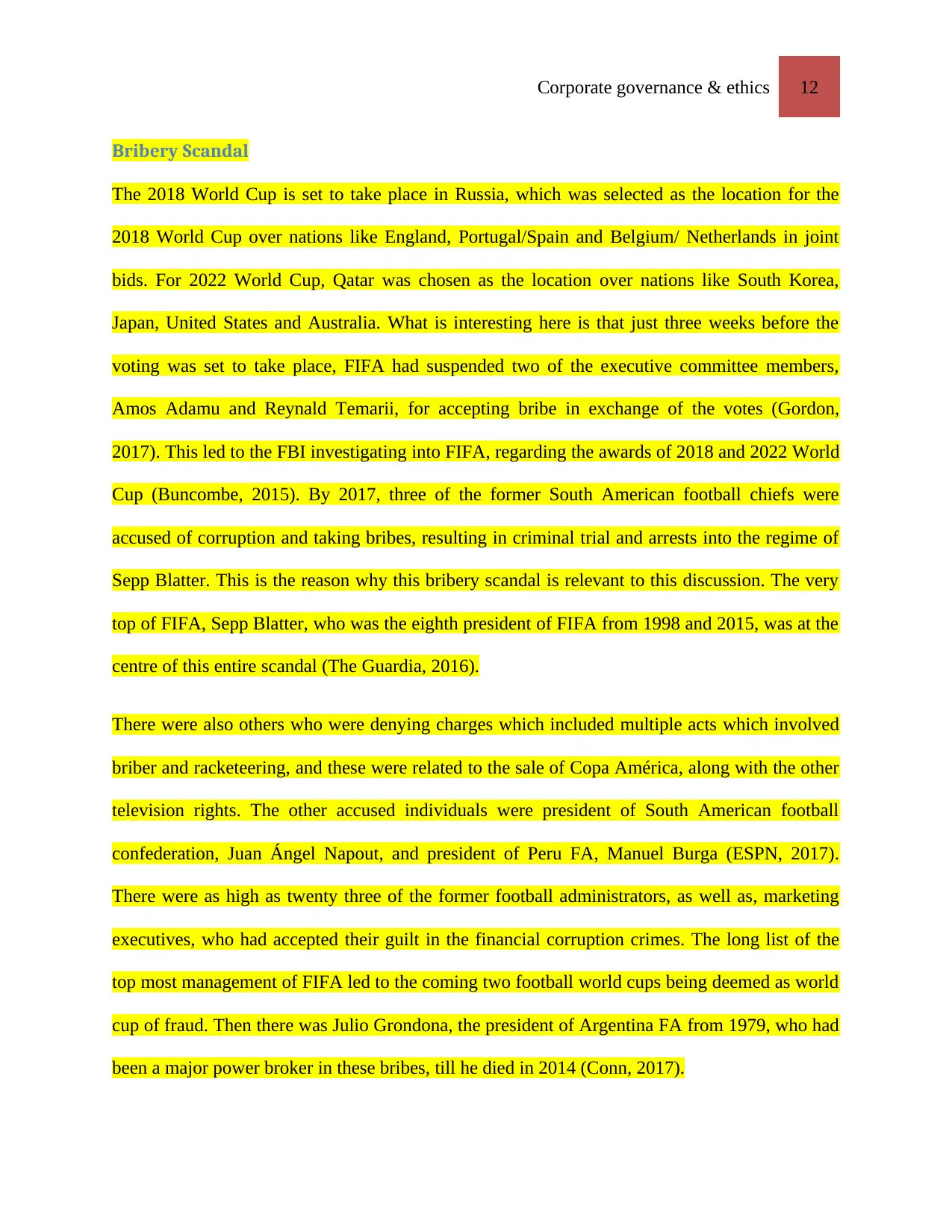
Corporate governance & ethics 12
Bribery Scandal
The 2018 World Cup is set to take place in Russia, which was selected as the location for the
2018 World Cup over nations like England, Portugal/Spain and Belgium/ Netherlands in joint
bids. For 2022 World Cup, Qatar was chosen as the location over nations like South Korea,
Japan, United States and Australia. What is interesting here is that just three weeks before the
voting was set to take place, FIFA had suspended two of the executive committee members,
Amos Adamu and Reynald Temarii, for accepting bribe in exchange of the votes (Gordon,
2017). This led to the FBI investigating into FIFA, regarding the awards of 2018 and 2022 World
Cup (Buncombe, 2015). By 2017, three of the former South American football chiefs were
accused of corruption and taking bribes, resulting in criminal trial and arrests into the regime of
Sepp Blatter. This is the reason why this bribery scandal is relevant to this discussion. The very
top of FIFA, Sepp Blatter, who was the eighth president of FIFA from 1998 and 2015, was at the
centre of this entire scandal (The Guardia, 2016).
There were also others who were denying charges which included multiple acts which involved
briber and racketeering, and these were related to the sale of Copa América, along with the other
television rights. The other accused individuals were president of South American football
confederation, Juan Ángel Napout, and president of Peru FA, Manuel Burga (ESPN, 2017).
There were as high as twenty three of the former football administrators, as well as, marketing
executives, who had accepted their guilt in the financial corruption crimes. The long list of the
top most management of FIFA led to the coming two football world cups being deemed as world
cup of fraud. Then there was Julio Grondona, the president of Argentina FA from 1979, who had
been a major power broker in these bribes, till he died in 2014 (Conn, 2017).
Bribery Scandal
The 2018 World Cup is set to take place in Russia, which was selected as the location for the
2018 World Cup over nations like England, Portugal/Spain and Belgium/ Netherlands in joint
bids. For 2022 World Cup, Qatar was chosen as the location over nations like South Korea,
Japan, United States and Australia. What is interesting here is that just three weeks before the
voting was set to take place, FIFA had suspended two of the executive committee members,
Amos Adamu and Reynald Temarii, for accepting bribe in exchange of the votes (Gordon,
2017). This led to the FBI investigating into FIFA, regarding the awards of 2018 and 2022 World
Cup (Buncombe, 2015). By 2017, three of the former South American football chiefs were
accused of corruption and taking bribes, resulting in criminal trial and arrests into the regime of
Sepp Blatter. This is the reason why this bribery scandal is relevant to this discussion. The very
top of FIFA, Sepp Blatter, who was the eighth president of FIFA from 1998 and 2015, was at the
centre of this entire scandal (The Guardia, 2016).
There were also others who were denying charges which included multiple acts which involved
briber and racketeering, and these were related to the sale of Copa América, along with the other
television rights. The other accused individuals were president of South American football
confederation, Juan Ángel Napout, and president of Peru FA, Manuel Burga (ESPN, 2017).
There were as high as twenty three of the former football administrators, as well as, marketing
executives, who had accepted their guilt in the financial corruption crimes. The long list of the
top most management of FIFA led to the coming two football world cups being deemed as world
cup of fraud. Then there was Julio Grondona, the president of Argentina FA from 1979, who had
been a major power broker in these bribes, till he died in 2014 (Conn, 2017).
⊘ This is a preview!⊘
Do you want full access?
Subscribe today to unlock all pages.

Trusted by 1+ million students worldwide
1 out of 19
Related Documents
Your All-in-One AI-Powered Toolkit for Academic Success.
+13062052269
info@desklib.com
Available 24*7 on WhatsApp / Email
![[object Object]](/_next/static/media/star-bottom.7253800d.svg)
Unlock your academic potential
Copyright © 2020–2025 A2Z Services. All Rights Reserved. Developed and managed by ZUCOL.




